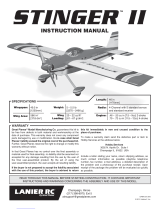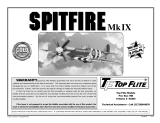Page is loading ...

Included in the box:
l Fuselage and battery canopy
l Motor and ESC
l Servos (pre-installed) x4
l Main wings x2
l Vertical stab
l Horizontal stab x2
l Engine cowling
l 10x4.7 slowfly prop and spinner
l Windshield x2
l Wire and wing members
l Scale landing gear
l Wheels x2
l Glue
l Pushrods
l Additional hardware (screws and
control horns)
Equipment required (not included):
l 4 channel radio and receiver
l Battery (3s 1300-1600mah)
l CA glue
l Drill with 2mm bit
l Small screwdrivers and Allen (hex)
keys
l Craft knife
l Scissors

Step 2: Finishing off the tail
First take two of the following control horns and enlarge one of the holes to 2mm. I used the
second hole from the end, and suggest this as a starting point. Moving inwards towards the base
will increase control surface throw while moving outwards will do the opposite. In any case, make
sure that you use equivalent holes for both elevator surfaces.
Now take the second type of control horn, together with the attached collet. Check to make sure
that the collet is free to rotate on the horn. If so, skip to the next step. If not, remove the collet,
enlarge the diameter of the hole to 2 mm and reassemble using just one washer.
Glue these in their respective locations as shown below. You may use the glue provided or faster

drying glue as you wish. Also glue the following two plastic parts in place. Please note that these
are not identical (i.e. there is a left-hand side part and a right-hand side part. Where each part goes
should be relatively obvious under closer inspection.)
Step 3: Lower main wing and landing gear
Remove the paper from the aileron servo wires and feed these through the plane as shown.
Aileron plug

Slot the wing in place. There is no need to glue. Next, take the landing gear and remove the
cable-tie holding it together. (Note there are small pieces in the landing gear bag that will need to
be kept safe until later, do not lose these)! Place in the slot provided, making sure that the landing
gear is orientated in the correct manner as shown below. Secure with the four screws provided. Do
not over-tighten these!
Install the following two plastic parts as shown. Not again that there is a LHS and an RHS part.
Finally, attach control horns, pushrods and clevises tail and shown below.
Blunt edge to the front,
sharp edge to the back.

Step 5: Plastic support members
First take the longest of the support members. There should be four of them provided with your
kit. Glue in place as below. Note the position of each of the pieces. Again, none are identical so
take this into account. The smooth side of each piece should face outwards.
Flip the plane over and secure with the following plastic parts. Again, note that these are not all
identical, but their correct locations should be fairly obvious.
Flip the plane back over and install the final two plastic members. These attach directly to the
fuselage.
Smooth side
Note, this shaped
piece is to be glued
in position here

Step 6: Upper main wing attachment
Glue the upper wing in place, atop the plastic parts previously put in.
Next, support wires should be installed. First, take one of the cables provided in your kit and tie a
knot in the end. Secure with CA and trim.
Now, examine the following image. Make sure that your glue from step 5 is fully dry.
Begin by feeding the cable through the hole labeled 1, then through 2 etc. Note, at hole 4 feed the
cable through the rearmost hole and back through the frontmost hole. After each pass through a
hole, secure in place using a drop of CA.

The cable should be a little taut, but not too tight that is sounds like a guitar string when plucked!
Also, try to arrange the tightness in each diagonal in such a way that the main wings remain
perfectly level, horizontal and straight.
Step 7: Cowl, prop and spinner attachment
First remove the battery canopy if not already done so, plus the spinner and washers from the
motor. Glue the cowl firmly in place. Make sure that the cowl is pushed as far upwards as
possible. Bear in mind that the battery canopy has a small lip that will go under the cowl and if it
is not glued in the correct position the lip of the canopy will rub against the motor.
Next slide one washer on, followed by the prop, a second washer and finally the spinner. Secure in
position. If the spinner is too loose on the shaft, or too tight against the cowl, remove the prop and
adjust the first nut on the motor shaft.
Step 8: Wheels
First, glue the plastic covers to each wheel as shown. (These plastic covers are hidden in a small
piece of yellow paper in your kit).

Enjoy!
l Pre-flight adjustment and trimming must be done before flying. Check that all
linkages, nuts, servo horns, linkage nuts and screws are tightened. Make sure
thread locks are applied where necessary.
l Ensure the flying field is spacious and safe to fly. Bench test the electronic power
system on load for 1 minute.
l Check all electronic equipment. Range check the radio equipment. Test all
control surface are moving in their assigned directions before each flight.
l Check battery voltage before use, even the batteries are recently charged.
l After the first flight, it is prudent to check the CG for all subsequent flights.
Attention!
/










